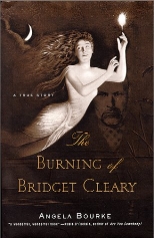
A fascinating, complext study: Angela Bourke has produced a scholarly detective story.
In Tipperary, Irish children still recite a rhyme that asks, "Are you a witch, or are you a fairy? Or are you the wife of Michael Cleary?"
Bridget Cleary, an attractive, strong-willed dressmaker, was 26 in 1895 when she was tortured and burned to death by her husband. Apparently he had come to believe she was a "changeling," left behind by fairies, or evil spirits, and that the "real Bridget" would reappear on a white horse at midnight. Seven of her neighbors and relatives, including her father and aunt, were convicted as accomplices.
The case of "The Tipperary Wife Burning" became a front-page sensation in the new mass media. English opponents of Irish home rule jumped on the news as evidence that the Irish could no more govern themselves than could African savages.
The story of Bridget Cleary endured and inspired a key scene in the 1992 novel Very Old Bones by William Kennedy, the great Irish-American novelist.
A century after the crime, Angela Bourke, an expert on the Irish oral tradition, has written The Burning of Bridget Cleary, an instructive and scholarly detective story.
Bourke, a professor at University College Dublin, uses the horrific murder as a springboard to tell a larger story about sex, religion and politics. She does justice to the grisly details and tabloid narrative, but the story's wider importance, she writes, "lies in the clash it illustrates between two different world views, two ways of dealing with troublesome people, two ways of accounting for the irrational, at a time of profound social, economic, and cultural change."
A whole world, the culture of those who had not learned to read and write but knew all about herbal cures and fairy legends, was becoming increasingly marginalized.
The strength of the book lies in Bourke's remarkable research, supported by 24 pages of footnotes, allowing her to go beyond the conventional explanations that attributed the murder to ignorance and superstition. ("'Superstition' simply labels what happened; it does not explain it," she writes.)
Bridget Cleary "had accumulated power, both economic and sexual, it seems, far in excess of what was due to a woman of her age and class, and when the balance tipped, all the anger flowed toward her," Bourke writes. "Police training, with its orderly categories, could not easily cope with such a seething confluence of motives."
The writing is admirably restrained, but the American edition of the book (it was first published in Britain and Ireland) offers little help to readers unfamiliar with the tangles of Anglo-Irish history, such as the Land War of 1879-82 between landlords and peasants.
But that's a minor complaint in a fascinating, complex study of what Bourke describes as "the sort of human tragedy in which nobody is entirely to blame, or entirely innocent."
The Burning of Bridget Cleary: A True Story
By Angela Bourke